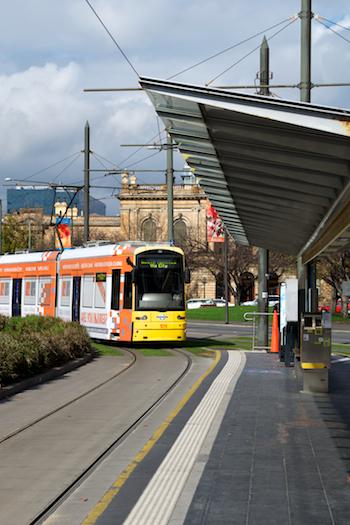On the tram
Duration/age

We went to visit the city one day and caught a tram along the way. What do you think we noticed that day?
Lots of different noises – car horns tooting, trucks reversing, clocks chiming, people talking, water rushing and tram bells sounding.
Lots of shiny windows – different shaped ones, reflective ones, open ones, ones with writing and ones you can see through.
Lots of signs – traffic signs, pedestrian signs, advertising, stop signs and shop signs.
Lots of people moving – quickly, slowly, riding, driving, holding hands and carrying bags.
Lots of buildings – open ones, closed ones, ones to eat in, old ones, new ones and some very, very tall ones.
Next time you are out and about in the city, talk to your child about the different things you see and hear.
Materials you will need
- Your eyes and ears
Skills this activity improves
Why does this matter?
Children have a natural sense of wonder about the world around them. Stopping and talking about the things you notice as you travel helps children to make sense of what they observe. It also helps them to organise the information into meaningful patterns.
Talking together about what you have noticed on your travels helps your child to ask questions. As they notice objects they can group them and compare the differences. As they talk about what they notice they are developing language to describe their thinking and observations.
When children begin to describe their thinking they have started to hypothesise. When they hypothesise they are beginning to connect what they see to past experiences and to use this information to make decisions, reflecting on why things have happened.
What does this lead to?
Some children are naturally curious and creative, taking risks in their learning. Children who are naturally curious and creative often notice and wonder about what they see around them. They will ask questions and create their own answers. These children have a natural disposition to be creative and curious.
Talking about and exploring the natural and everyday environment with your child will help them to develop the skills to notice, take risks and ask questions. Even if your child does not have a natural disposition to be creative and curious, by exploring and posing questions you are helping your child to experiment with different ways of thinking.
Language to use
- Sight, view, vision, see
- Hear, sound, noise, chirp, beep, buzzing, tooting, dinging
- Window, surface, door, ground, building, rubbish bin, clock
- Long, short, round, patterned, high, tall
- Car, bike, tram, bus, truck
- Signs, traffic sign, pedestrian crossing, stop sign, tram stop, traffic light
- Bus lane, bike lane, traffic
- Quickly, slowly, fast
- Open, closed
Questions to use
- Do all buildings have the same shaped windows?
- Where do you think the people are going?
- What might be in the bags they are carrying?
- How will we know when the tram is coming?
- Why does the bus have its own lane?
Useful tips
- If your child is younger you could make a book of things to notice before you go out and about.
- Remember to talk to your child in your home language.
More ideas
- Make a list of things you have noticed when you are out and about. Sort them into what you like or don’t like.
- Take photos of your wonderings and noticings. You could use these to make cards, lotto games or memory cards.
- Make your own storybook.
Variation by age
Birth to two year olds
- Sing the song “the wheels on the tram go round and round" when you are on the tram.
- Borrow books from the local library that are about noticing and wondering.
- When you get home build a city with your child and pretend you are back in town on the tram.
Three to five year olds
- Make a map of the route you have travelled. Mark on the map where you have noticed different things.
- Borrow books from the local library that are about noticing and wondering.
- Try and discover a new describing word every day.
- Make a word wall.
Questions to ask
- Where is the door of the shop?
- Which building is bigger?
- How will we get onto the tram?
- What noise does a car make?
Questions to ask
- Which direction are we going?
- If we walked a different way would we see the same things?
- Will we see more men or more women?
Language to use
- Hear, sound, noise, chirp, beep, buzzing, tooting, dinging
- Window, surface, door, ground, building, rubbish bin, clock
- Long, short, round, patterned, high, tall
- Car, bike, tram, bus, truck
- Signs, traffic sign, pedestrian, stop sign, crossing, tram stop, traffic light
- Bus lane, bike lane, traffic
- Open, closed
Language to use
- Window, surface, door, ground, building, rubbish bin, clock
- Long, short, round, patterned, high, tall
- Car, bike, tram, bus, truck
- Signs, traffic sign, pedestrian, stop sign, crossing, tram stop, traffic light
- Bus lane, bike lane, traffic
- Route, map, plan, direction, location
- Words, language, description


